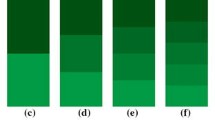Abstract
Traditional camouflage pattern painting is not effective enough due to development of the high-tech reconnaissance. The recently proposed digital pattern painting, a new form of camouflage pattern painting, which has better performance in countering reconnaissance. In this study, we present a novel design and evaluation of digital camouflage pattern based on spot combination. Firstly, we compared three clustering algorithms to extract dominant colors. At the meantime, on the basis of spot database, a spot combination algorithm is proposed to generate camouflage spot pattern. Finally, we evaluate its camouflage effect using saliency map based on human visual perception mechanism, as well as detection time. The herein proposed digital camouflage pattern can effectively blend with surrounding background, significantly prolong the detection time, and thus has a good camouflage effect.










Similar content being viewed by others
References
Thayer GH, Thayer AH (1909) Concealing-coloration in the animal kingdom: an exposition of the Laws of disguise through color and pattern: being a summary of Abbott H. Thayer's Discoveries, Macmillan Company
Cott HB (1941) Adaptive coloration in animals. Oxford University Press, New York
(2009). Camouflage on the modern battlefield, interview with Mr. Anders Wiman, president of Saab Barracuda. Military Technology, (7): 71–72.
Xue F, Xu S, Luo YT et al (2015) Design of digital camouflage by recursive overlapping of pattern templates. Neurocomputing 172(C):262–270
O’Neill TR, Brusitus JM, Taylor DL et al (1978) Evaluation of dual-texture gradient camouflage pattern:ADA056471
Xue F, Wu F, Wang JW et al (2018) Camouflage texture design based on its camouflage performance evaluation. Neurocomputing 274:106–114. https://doi.org/10.1016/j.neucom.2016.07.081
Cuthill IC, Stevens M, Sheppard J, Maddocks T, Párraga CA, Troscianko TS (2005) Disruptive coloration and background pattern matching. Nature 434(3):72–74
Merilaita S, Lind J (2005) Background-matching and disruptive coloration, and the evolution of cryptic coloration. Proc R Soc B 272(5):665–670
Todd PA (2009) Testing for camouflage using virtual prey and human ‘predators’. J Biol Educ 43(2):81–84
Marshall NJ, Messenger JB (1996) Colour-blind camouflage. Nature 382(6):408–409
Gonzalez-Bellido PT, Scaros AT, Hanlon RT et al (2018) Neural Control of Dynamic 3-Dimensional Skin Papillae for Cuttlefish Camouflage. In: Neural control of dynamic 3-dimensional skin papillae for cuttlefish camouflage, iScience, 1(1), 34–34. https://doi.org/10.1016/j.isci.2018.01.001
Chiao CC, Emma JK, Roger TH (2005) Disruptive body patterning of cuttlefish (Sepia officinalis) requires visual information regarding edges and contrast of objects in natural substrate backgrounds. Biol Bull 208(7):7–11
Mäthger LM, Barbosa A, Miner S, Hanlon RT (2006) Color blindness and contrast perception in cuttlefish (Sepia officinalis) determined by a visual sensorimotor assay. Vis Res 46(5):1746–1753
Zylinski S, Osorio D, Shohet AJ (2009) Cuttlefish camouflage: context-dependent body pattern use during motion. Proc R Soc B 276:3963–3969
Buresch KC, Ulmer KM, Akkaynak D, Allen JJ, Mäthger LM, Nakamura M, Hanlon RT (2015) Cuttlefish adjust body pattern intensity with respect to substrate intensity to aid camouflage, but do not camouflage in extremely low light. J Exp Mar Biol Ecol 462:121–126
M. A. Hogervorst, A. Toet, P. Jacobs. (2010). Design and evaluation of (urban) camouflage. Proc. of SPIE, 7662: 766205-766205-11.
M. Friškovec, H. Gabrijelčič, B. Simončič. (2010). Design and evaluation of a camouflage pattern for the Slovenian urban environment. Journal of imaging science and technology, 54(2): 020507-020507-11.
Friškovec M, Gabrijelčič H (2010) Development of a procedure for camouflage pattern design. Fibres & Textiles in Eastern Europe, 18 4(81):68–76
L. Hepfinger, C. Stewardson, K. Rock, et al. (2010). Soldier camouflage for operation enduring freedom (OEF): pattern-in-picture (PIP) technique for expedient human-in-the-loop camouflage assessment. ADA532947.
Zheng YF, Zhang XW, Wang F, Cao TY, Sun M, Wang XB (2019) Detection of people with camouflage pattern via dense deconvolution network. IEEE Signal Processing Letters 26(1):29–33
Le TN, Nguyen TV, Nie ZL, Tran MT, Sugimoto A (2019) Anabranch network for camouflaged object segmentation. Comput Vis Image Underst 184:45–56
Xu Y (2007) Camouflage color selection based on dominant color extraction. Opto-Electronic Engineering 34(1):100–103
Lü XL, Lin W, Xu WD et al (2005) Applying the fuzzy clustering analysis of ISODATA to the classification of camouflage effectiveness. Acta Armamentarii 26(5):681–684
Q. Jia, X. L. Lü., W. D. Xu, et al. (2018). Clust Comput, https://doi.org/10.1007/s10586-018-2129-8
Jing HY, He X, Han Q et al (2014) Saliency detection based on integrated features. Neurocomputing 129:114–121
Itti L, Koch C, Niebur E (1998) A model of saliency-based visual attention for rapid scene analysis. IEEE Transactions on Pattern Analysis & Machine Intelligence 20(11):1254–1259
Jia Q, Lü XL, Wu C et al (2011) Evaluation of camouflage effectiveness using human visual attention mechanism. J Appl Sci 29(3):294–298
Fan DP, Cheng MM, Liu JJ et al (2018) Salient objects in clutter: bringing salient object detection to the foreground. European conference on computer vision (ECCV): 196-212. https://doi.org/10.1007/978-3-030-01267-0_12
J. X. Zhao, J. J. Liu, D. P. Fan, Y. Gao, J. F. Yang, M. M. Cheng. (2019). EGNet: edge guidance network for salient object detection, IEEE international conference on computer vision (ICCV), 2019.
Fu KR, Zhao QJ, Gu IYH, Yang J (2019) Deepside: a general deep framework for salient object detection. Neurocomputing 356:69–82
W. G. Wang, Q. X. Lai, H. Z. Fu, J. B. Shen, H. B. Ling, R. G. Yang. (2020). Salient object detection in the deep learning era: an in-depth survey. Computer vision and pattern recognition (cs.CV). arXiv preprint arXiv:1904.09146.
Author information
Authors and Affiliations
Corresponding authors
Additional information
Publisher’s note
Springer Nature remains neutral with regard to jurisdictional claims in published maps and institutional affiliations.
Rights and permissions
About this article
Cite this article
Jia, Q., Xu, W.D., Hu, J.H. et al. Design and evaluation of digital camouflage pattern by spot combination. Multimed Tools Appl 79, 22047–22064 (2020). https://doi.org/10.1007/s11042-020-09002-5
Received:
Revised:
Accepted:
Published:
Issue Date:
DOI: https://doi.org/10.1007/s11042-020-09002-5




